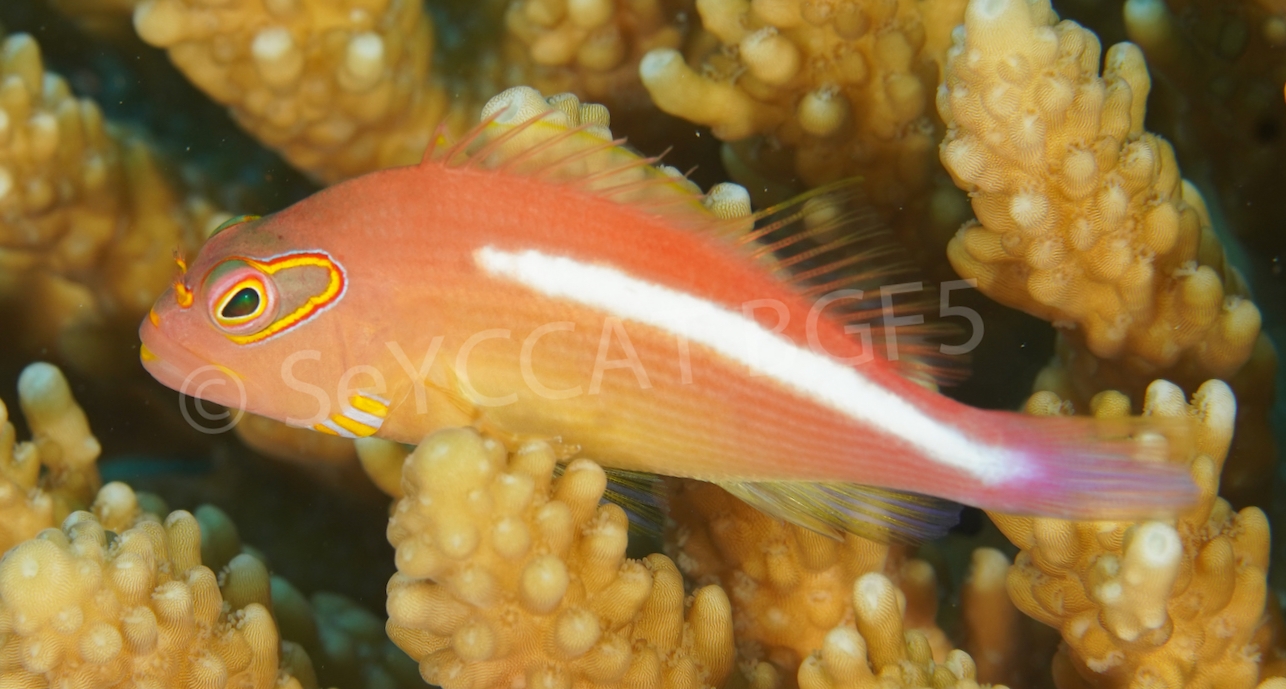Description:
Dorsal spines: 10; Dorsal rays: 11; Anal spines: 3; Anal rays: 6.
Medum-sized hawkfish. Body elongate. Snout short. Mouth large, the maxilla reaching posterior to a vertical at centre of eye. Cirri in front of eye. 5 or 6 rows of scales on
cheek. Interorbital space and snout to nostrils scaly. Dorsal fin continuous, notched between spinous and soft portions. A single cirrus from membrane near tip of each
dorsal-fin spine. 5 rows of scales above lateral line. Caudal fin slightly rounded.
Colour. Occurs in a variety of color morphs, but always has a distinctive ring extending around and behind the eye. The u-shaped ring behind the eye is enclosed by a
tricoloured border of orange, dark brown and light blue. Lower part of gill cover has pale blue area with three short orange bars. Usually a broad pale stripe (pink or white)
from upper side to caudal fin. There is a dark colour morph without the pale body stripe.
Size:
Maturity: Unknown. Max length : 20.0 cm TL.
(There is variance in the literature regarding max size varying from 9 cm to 20 cm TL).
Habitat and Ecology:
Solitary species that inhabits coastal lagoons and seaward reefs (depth typically 1-35m, but reported from as deep as 91 m). Usually found perching on small branching corals.
Feed mainly on shrimps, small fishes, crabs, and other crustaceans. Distinct pairing.
Demartini and Donaldson (1996) found the relative abundance of the 2 most common colour morphs (White-striped and melanistic) were generally related to depth. The white stripe morph more common at depths > 10m. "Patterns of color morph frequencies in P. arcatus may represent trade-offs between intraspecific communication and predation risk that exist at differing coral and fish densities."
Fishery Status:
This species is not protected or subject to fishery regulations. It is not subject to the artisanal fishery.
Notes:
Photo courtesy Eleanor Brighton and Chris Mason-Parker (c) 2022 Blue Safari Seychelles/Marine Conservation Society, Seychelles. Photograph taken at Alphonse group 2022.
References:
Bray, D.J. (2019). Paracirrhites arcatus in Fishes of Australia, https://fishesofaustralia.net.au/home/species/440 (19/07/22).
DeMartini, E.E. & Donaldson, T. (1996). Color Morph-Habitat Relations in the Arc-Eye Hawkfish Paracirrhites arcatus (Pisces: Cirrhitidae), May 1996 Copeia 1996(2):362 DOI: 10.2307/1446852
Froese, R. & D. Pauly. (Eds). (2022). FishBase. https://www.fishbase.de/summary/5835 (19/07/22).
Greenfield, D. & Williams, I. (2016). Paracirrhites arcatus (errata version 2017). The IUCN Red List 2016: https://dx.doi.org/10.2305/IUCN.UK.2016-1.RLTS.T67997869A68001716.en. (19/07/22).
McGrouther, M. (2021). Ringeye Hawkfish, Paracirrhites arcatus (Cuvier, 1829). https://australian.museum/learn/animals/fishes/ringeye-hawkfish-paracirrhites-arcatus/ (19/09/22).
Paracirrhites arcatus (Cuvier, 1829) in GBIF Secretariat (2021). GBIF Backbone Taxonomy. Checklist dataset https://doi.org/10.15468/39omei (19/07/22).
Smith, M. & Heemstra, P. (Eds.) (1999). Smiths’ Sea Fishes Edition 6. Springer-Verlag Berlin Heidelberg 10.1007/978-3-642-82858-4
Citation:
Nevill, J.E.G., Brighton, E. & Mason-Parker, C. (2022). Paracirrhites arcatus, Arc-eye hawkfish. Seychelles Seatizens. www.seatizens.sc. https://seatizens.sc/species/paracirrhites-arcatus-cuvier-1829/


pin up az?rbaycan: pin up giris – pin up casino
pin up onlayn kazino https://azerbaijancuisine.com/# pin up
pin-up online casino
mexican border pharmacies shipping to usa: mexican mail order pharmacies – mexican online pharmacies prescription drugs
https://northern-doctors.org/# п»їbest mexican online pharmacies
mexican mail order pharmacies Mexico pharmacy that ship to usa mexican online pharmacies prescription drugs
http://northern-doctors.org/# buying from online mexican pharmacy
mexico drug stores pharmacies mexican pharmacy mexican mail order pharmacies
https://northern-doctors.org/# mexico drug stores pharmacies
http://northern-doctors.org/# buying prescription drugs in mexico online
mexico pharmacies prescription drugs mexican pharmacy northern doctors mexican online pharmacies prescription drugs
https://northern-doctors.org/# medication from mexico pharmacy
http://northern-doctors.org/# best online pharmacies in mexico
mexican mail order pharmacies mexican northern doctors mexican border pharmacies shipping to usa
https://northern-doctors.org/# mexican pharmaceuticals online
https://northern-doctors.org/# medicine in mexico pharmacies
https://northern-doctors.org/# mexican border pharmacies shipping to usa
Your humor added a lot to this topic! For additional info, click here: FIND OUT MORE. What do you think?
https://northern-doctors.org/# buying from online mexican pharmacy
https://northern-doctors.org/# mexico drug stores pharmacies
https://northern-doctors.org/# mexico pharmacies prescription drugs
mexican rx online mexican pharmacy online pharmacies in mexico that ship to usa
https://northern-doctors.org/# medication from mexico pharmacy
mexico drug stores pharmacies mexican pharmacy northern doctors mexican mail order pharmacies
https://northern-doctors.org/# medication from mexico pharmacy
https://cmqpharma.com/# purple pharmacy mexico price list
medicine in mexico pharmacies
pharmacies in mexico that ship to usa buying prescription drugs in mexico mexico pharmacy
http://indiapharmast.com/# п»їlegitimate online pharmacies india
world pharmacy india: world pharmacy india – Online medicine order
reputable canadian online pharmacies: legitimate canadian online pharmacies – canadian pharmacy store
pharmacies in mexico that ship to usa: mexican mail order pharmacies – best online pharmacies in mexico
http://canadapharmast.com/# best online canadian pharmacy
mexican mail order pharmacies mexican drugstore online medicine in mexico pharmacies
п»їlegitimate online pharmacies india: online pharmacy india – india online pharmacy
https://indiapharmast.com/# Online medicine order
pharmacy in canada canadian drugs canadadrugpharmacy com
mexican rx online: purple pharmacy mexico price list – reputable mexican pharmacies online
Online medicine order: п»їlegitimate online pharmacies india – online pharmacy india
http://clomiddelivery.pro/# how can i get cheap clomid without dr prescription
http://paxloviddelivery.pro/# paxlovid price
where can i get generic clomid now: how to buy cheap clomid now – how to get cheap clomid without a prescription
http://paxloviddelivery.pro/# paxlovid pharmacy
doxycycline 100mg cost australia: doxycycline 100 mg tablets – doxycycline tab india
https://clomiddelivery.pro/# generic clomid online
https://doxycyclinedelivery.pro/# cost doxycycline tablets
paxlovid india: paxlovid pharmacy – Paxlovid buy online
https://ciprodelivery.pro/# buy ciprofloxacin
http://amoxildelivery.pro/# amoxicillin capsule 500mg price
where to get cheap clomid without dr prescription: get cheap clomid online – where to get clomid without dr prescription
https://clomiddelivery.pro/# can you get cheap clomid prices
cipro for sale: buy ciprofloxacin over the counter – ciprofloxacin generic
amoxicillin 500 mg: buy amoxicillin 500mg usa – buy amoxicillin canada